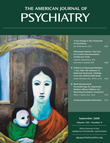A Genome Screen for Quantitative Trait Loci Influencing Schizophrenia and Neurocognitive Phenotypes
Abstract
Objective: Deficits in neurocognitive function have been demonstrated in individuals with schizophrenia and in the unaffected family members of these individuals. Genetic studies of such complementary traits, along with traditional analyses of diagnosis, may help to elucidate the biological pathways underlying familial liability to schizophrenia and related disorders. The authors conducted a multiplex, multigenerational family study using a genome-wide screen for schizophrenia and related neurocognitive phenotypes. Method: Participants were 1) 676 European American individuals from 43 families, ascertained through an individual with schizophrenia, and 2) 236 healthy comparison subjects. Participants were evaluated clinically and examined through the use of a computerized neurocognitive test battery that provided measures of accuracy and speed on the cognitive domains of abstraction and mental flexibility; attention; verbal, face, and spatial memory; language and reasoning; spatial and emotion processing; and sensorimotor dexterity. A genome-wide linkage screen was also performed. Healthy comparison subjects were included in order to obtain normative phenotypic data but were not genotyped. Results: Significant evidence for linkage of schizophrenia to chromosome 19q was observed. Analysis of cognitive traits revealed significant linkage to chromosome 5q for the domains of abstraction and mental flexibility. A variety of other neurocognitive traits also showed nominal evidence of linkage to the 5q region. Joint analyses with diagnosis suggested that this quantitative trait locus may also influence schizophrenia. Conclusions: Although chromosome 5 has been implicated in previous linkage studies of schizophrenia, the identification of the chromosome 19 quantitative trait locus is a novel finding. The identification of the chromosome 5 quantitative trait locus through linkage to neurocognitive phenotypes in the present study may inform functional hypotheses pertaining to how genotypes are connected to disease.



